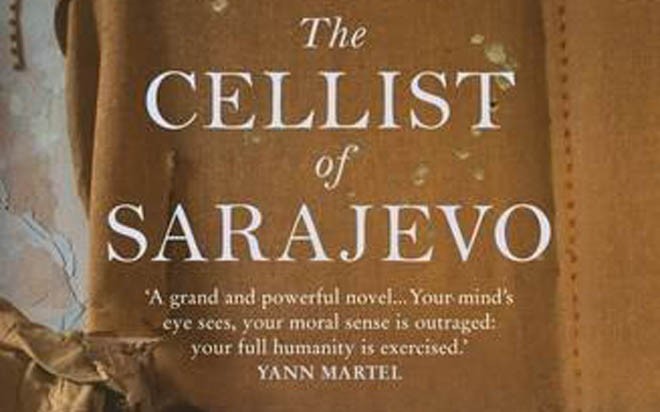
The siege of Sarajevo explored through the lives of three disparate characters

The siege of Sarajevo was one of the first wars to be televised in real time for a global audience. The televised atrocities against the inhabitants of Sarajevo, trapped in the suffocating siege, inspired worldwide compassion. Some writers and activists rushed to the theatre of war to help the trapped residents in sustaining their spirit of resistance. Susan Sontag pitched her tent there and helped Becket produce Waiting for Godot. Other novels and films followed.
For many writers Sarajevo become the symbol of pluralism and mutual coexistence in a multi-ethnic and multi-faith setting. Such writers endeavoured to write about the tragedy of Sarajevo in order to preserve the city in their minds. Salman Rushdie’s quote, "There is a Sarajevo of the mind, an imagined Sarajevo whose present ruination and torment exiles us all", perfectly encapsulates this mood.
Steven Galloway novel’s The Cellist of Sarajevo is in the same compassionate, campaigning tradition. The novel is about Serbian men occupying strategic hills overlooking Sarajevo and those living in the firing range of the snipers. The novel charts three lives under siege and the deadly effects of the war on their daily peaceful routine. The story of siege and its effects is told through three characters: Kenan, Dragan and Arrow. The unifying character is that of a cellist, based on a real character, who resolves to play Albinoni’s Adagio for 22 days in remembrance of the 22 people killed in a terrible marketplace massacre during the conflict.
This seminal event gives form and coherence to the narrative, which broadens from resistance through music, to the daily struggle of keeping alive in the face of war amid a spawning war-mafia economy.
Kenan’s story fleshes out the weekly efforts of procuring safe and potable water for his family. As the war drags on, the city is starved of water and other essentials. The only place to get pure water is the nearby brewery which has thus far survived annihilation. Kenan undertakes the weekly ritual of taking his empty water cans to the brewery and bringing them back filled up; often dodging bullets from snipers ensconced at the top of the hills.
He feels chafed under the extra burden of procuring water for his elderly female neighbour who has been far from kind to Kenan and his family. Kenan’s character tells the story of a peace-loving and obedient man struggling to keep his family together.
His friend, Ismat, unlike Kenan, has joined a faction of the army. They often share a smoke and reminisce about times of peace and togetherness.
Dragan acts as a witness and chronicler of the famous sniper alley which was the target of snipers rooted in the hills. People crossing over to the other side of the street inevitably came under their fire. Dragan, a bakery worker, finds it a daily struggle to leave his apartment and cross the street to fetch bread for his sister and brother-in-law, with whom he lives. Dragan’s family members have already left for the safety of Italy, but nostalgic Dragan refuses to leave the Sarajevo; he harks back to the days of peace and harmony.
One day, at the crossing he reconnects with some acquaintances he has not seen for years. One such acquaintance is Emina, his wife’s friend. While she is attempting to cross the street, she is hit by a sniper and Dragan watches her die. For a large number of people, the sniper alley represented the firing zone between life and death, hunger and food, and employment or penury.
By far the strongest character is Arrow, a woman fired with passion for justice. Yet Arrow is a different type of fighter -- the antithesis of snipers since she hates firing at non-combatants. Her assigned mission is to protect the cellist who offers hope and resistance through his music. The cellist continues making his music, unaffected by the fact that location is a prime target within the snipers’ radar. Arrow, his protector, scans any potential shooters primed to fire at the cellist from the surrounding hills. She manages to kill snipers who are likely to fire at the cellist. When her mission of warding off threats to the musician’s life is accomplished, she leaves the guerrilla force.
However, if you have served as a soldier in a drawn-out war, it is difficult to extricate yourself from further involvement. The war mafia draws her back into guerrilla life after the death of their commander. In war there are hardly any shades of grey. The new commander is very practical and does not allow her to choose her targets. Arrow is required to shoot, against her principles, at civilians.
The Cellist of Sarajevo is fast-paced in a journalistic way; the novel has won many prizes and was on The New York Times best seller list. One critique is that the characters are devoid of depth and emotional complexity. This may be because of the exigencies of the engulfing war. I found the novel to serve as a good snapshot of the siege of Sarajevo, at street, family and personal levels. Walking thorough Sarajevo and looking at the bullet-marked building facades and then squaring this experience with The Cellist of Sarajevo gives a deep insight into life during the brutal siege.
Efforts to fill out the city’s bullet-riddled building facades makes scars stand out even more, proving how deep psychic wounds can run. The wounds linger on in buildings, minds, bodies and the national psyche, hence producing fragmented narratives. The city is still uneasily picking its way through the sniper alley and the market place where the cellist played music for 21 days. Yet despite this, life in the city goes on.
Although the city is still struggling to recover its harmonious past, the citizens of Sarajevo continue to live as best as they can despite the externally imposed political arrangements.